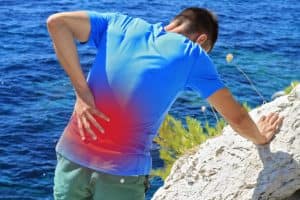Low Back Pain – Tips to a Healthy Back
Understanding Your Back
Low back pain affects people from all walks of life. Approximately eighty percent of adults will experience this ailment at some point in their lives. However, it doesn’t have to be debilitating. A few common-sense rules to use and a basic understanding of your back will decrease most of the anxiety associated with this condition. This article is not intended to be a substitute for a visit to your doctor. Most of the conditions that cause back pain are not life-threatening, however, a thorough history and physical exam is necessary to rule out more serious problems.

First, your back, or lumbar spine, is not meant to be a stand-alone structure. It is essential to have strong muscles in your abdomen (belly) and in your back. It is commonly thought that back pain is the result of weak back muscles, but this is usually not the case. It is far more common to have weak abdominal muscles that allow your back to develop excessive sway: medically referred to as lordosis. This excessive lordosis coupled with tight hamstring (back of the thigh) and buttock muscles can cause significant back pain. Your back needs proper support in order to maintain normal alignment and function, which means good posture. This does not suggest that an external brace is appropriate for most back pain. Also, that belly hanging out front can cause significant sway. Proper weight for your height is extremely important (see BMI chart). Body Mass Index may not be appropriate for very muscular individuals, but applies to most adults.
Exercise
Part of a good overall healthy regimen is to regularly exercise. This is also very true for your back. How you exercise can significantly affect your back. Try to avoid stooped postures (bending forward at the waist). Those dead-lifts you did for high school football are typically not appropriate for the aging back. Weight-lifting is part of a healthy lifestyle for most people and should be incorporated into your workouts after a check-up with your primary care doctor. How you lift weights is as important as or even more important than how much you lift. Anybody not familiar with weights and weight machines should receive proper training. Where you work out is also a key element in the prevention of back and lower extremity injuries. Minimize high-impact workouts on hard surfaces. Concrete sidewalks are very hard. Runners and walkers are generally recommended to avoid sidewalks and to use dirt, asphalt, or wood chip trails.
Footwear

Footwear is another significant element in the prevention of back pain. It is important to wear shoes that are the correct shape and size. This is true for your work and workout shoes. Shoes that are too small or that fit poorly will affect your walking pattern. This can lead to overuse injuries in your feet and your back. High heels may be appropriate for some occasions, but they cause excessive lordosis. Also, socks that are a blend of wool, acrylic and/or cotton are best- they take the sweat away and maintain their cushioning ability. Pick your shoes and socks wisely: your entire body is resting on them.
Tobacco Use
Tobacco use is also known to increase the incidence of back pain. Scientists are not able to determine how all of the chemicals in tobacco affect the human body. However, nicotine is known to cause our arteries to constrict, or get smaller, and this can decrease blood circulation to certain body parts. There are areas of our bodies that receive minimal blood. The discs, or cushions, in your back are in that category. These complex structures are between most of the bones in your spine, and they act like shock absorbers and stabilizers. Therefore, when their already poor blood supply is compromised, it is natural to assume that this could lead to degeneration. Cessation of tobacco use is not likely to affect your back pain in the short term, but it could have a positive long term affect. Tobacco use can also contribute to a poor surgical outcome. In fact, many plastic surgeons and spine surgeons will not perform some types of procedures on patients who use tobacco.
Low back pain is extremely common, but usually short-lived. In most cases, it does not last more that six to twelve weeks, and many times only a few days. Initial treatment is usually acetaminophen or anti-inflammatory medication, short duration of rest, and avoidance of offending activities. Long term bed rest can actually make the problem worse. Doctors will often prescribe physical therapy and certain kinds of medications for persistent pain. Surgery is typically not necessary for back pain alone. However, in the patient with six or more months of constant, severe back pain, surgery can be appropriate. Emerging techniques and implants have given doctors new ways of addressing an old problem. Know that you are not alone and keep exercising.
Ten Tips to a Healthy Back
1) Lose weight when appropriate- see BMI
2) Perform regular cardiovascular exercise- it helps circulation EVERYWHERE
3) Maintain good flexibility- especially of hamstring and buttock muscles
4) Wear shoes that are supportive and fit well
5) Minimize high-impact activities on hard surfaces
6) Avoid high heeled shoes
7) STOP SMOKING- it inhibits circulation EVERYWHERE
8) Wear wool, acrylic, and cotton blend socks
9) Maintain good body posture
10) Use proper weight-lifting techniques- form over weight


Dr. Trimble is Board Certified in Orthopaedic Surgery. His areas of clinical interests include spine surgery, general orthoapedic surgery, Ocuupational and rehabilitation medicine, arthroscopic surgery and minimally invasive surgery. Dr. Trimble attended medical school at Western University of Health Sciences and completed his residency in Orthopaedic Surgery at Mount Clemens General Hospital. He also performed a fellowship in spine surgery at the Florida Spine Institute. Dr. Trimble is a member of the American Osteopathic Association, American Osteopathic Acadamy of Orthopaedics and the Alachua County Medical Society.He enjoys time with family, bicycle riding, and traveling in his spare time.


